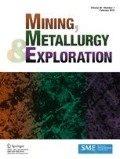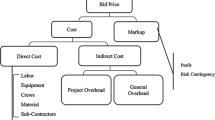Abstract
A case study was conducted on a metal mine operating in Kazakhstan, in which problems were associated with use of a complicated and outdated ventilation system and its high expenses. The mine needs to reconsider its existing ventilation system and identify the risks associated with operational losses when using this ventilation system. The aim of this study was to develop an efficient risk analysis method capable of estimating operational risks and financial benefits of the existing mine ventilation system. The developed risk analysis method considers ventilation modelling, risk modelling, and financial modelling. Ventilation modelling comprises ventilation simulation and ventilation financial simulation. In risk modelling, the number of risk events occurring with the use of existing ventilation system and the operational losses during these events is estimated. Financial modelling considers operational losses and ventilation financial simulation benefits and uses a dynamic cash flow model to estimate how cost variability influences the cash flow. As a result, the improved ventilation system attains an additional NPVa ranging from 3.2 to 8.5 million US$ at the corresponding defined probability of 90%. The results of this study reveal that the developed risk analysis method can efficiently estimate the financial benefits of ventilation modelling and consider risk events and their total operational losses associated with use of the existing ventilation system. This approach provides a range of possible outcomes and helps with deciding whether the ventilation system is appropriate or whether it should be updated to better suit the project financial benefits.











Similar content being viewed by others
References
Sabanov S (2019) Financial risk analysis of optimized ventilation system in the gold mine. Springer Nature 2019, book chapter: Proceedings of the 27th International Symposium on Mine Planning and Equipment Selection - MPES 2018. https://doi.org/10.1007/978-3-319-99220-4_3
Kocsis C, Hardcastle S (2003) Ventilation system operating cost comparison between a conventional and an automated underground metal mine. Technical Papers 55:57–64
De Souza E (2015) Improving the energy efficiency of mine fan assemblages. Appl Therm Eng 90:1092–1097
El-Nagdy K, Shoaib AM, A. (2015) Alternate solutions for mine ventilation network to keep a preassigned fixed quantity in a working place. Int J Coal Sci Technol (2015) 2(4):269–278
Wu, ZL., Li, HS. (1993). Simulation of mine ventilation under the influence of mine fires. In: Proceedings of the US mine ventilation symposium, University of Utah, pp. 359–363, June 21–23
Wu H and Gillies A (2005) Real-time airflow monitoring and control within the mine production system. Eighth International Mine Ventilation Congress, pp.383-389.
Chatterjee A, Zhang L, Xia X (2015) Optimization of mine ventilation fan speeds according to ventilation on demand and time of use tariff. Appl Energy 146:65–73
McPherson M (2009) Subsurface ventilation and environmental engineering. Chapman & Hall, London
Wei G (2011) Optimization of mine ventilation system based on bionics algorithm. Procedia Engineering 26:1614–1619
Wen-Xun X, Jin-Xing X (1999) Modern optimization computing algorithms. QingHua University Publishers, BeiJing, pp 156–158
Kaiyan C, Si J, Zhou F, Zhang R, Shao H, Zhao H (2015) Optimization of air quantity regulation in mine ventilation networks using the improved differential evolution algorithm and critical path method. Int J Min Sci Technol 25(1):79–84
Chiandussi G, Codegone M, Ferrero S (2009) Topology optimization with optimality criteria and transmissible loads. Comput Math Appl 57(5):772–788
Szlązak N, Obracaj D, Korzec M (2017) Analysis of connecting a forcing fan to a multiple fan ventilation network of a real-life mine. Process Saf Environ Prot 107:468–479
Mrozek M (1996) Topological invariants, multivalued maps and computer assisted proofs in dynamics. Comput Math Appl 32(4):83–104
Zhou C, Damiano N, Whisner B, Reyes M (2017) Industrial Internet of Things (IIoT) applications in underground coal mines. Min Eng 69(12):50–56
Sabanov S, Tussupbekov Y, Karzhau A, Aldamzharov B (2019) Risks Analysis for Ventilation Network Optimisation Processes in Kazakhstan Metal Mines. Proceedings of the 17th North American Ventilation Symposium, pp. 545-553.
Zhou Q, Arnbjerg-Nielsen K (2018) Uncertainty assessment of climate change adaptation options using an economic pluvial flood risk framework. Water 2018(10):1877
Samis M, Davis G (2014) Using Monte Carlo simulation with DCF and real options risk pricing techniques to analyse a mine financing proposal. Int J Financial Eng Risk Manage, 2014, 1(3): 264–281.
Kazakhstan mining regulations requirements for underground mine ventilation (2004). Retrieved from http://egov.kz/cms/ru/law/list/P090002207_
Yua TP, Lub P, Wanga Q, Suna J (2013) Optimization of ventilating energy distribution for controlling coal spontaneous combustion of sealed panel in underground coal mines. Procedia Engineering 62(2013):972–979
Nyaaba W, Frimpong S.S, El-Nagdy KA (2014) Optimisation of mine ventilation networks using the Lagrangia algorithm for equality constraints. In: 12th international conference on mining, petroleum and metallurgical engineering MPM12, Suez University, 20–22 Oct 2014
Wang X, Xiong J, and Xie J (2018) Evaluation of measurement uncertainty based on Monte Carlo method. MATEC Web of Conferences 206, 04004 (2018), ICCEMS 2018.
Ni Y (2015) Practical evaluation of uncertainty in measurement (5th edition). Beijing: China zhijian publishing house, Standards press of China, pp. 35-54, 2015
Pyrcz MJ, Deutsch CV (2014) Geostatistical reservoir modeling. OUP, USA
Deutsch CV, Journel AG (1998) GSLIB: Geostatistical software library and user’s guide. New York, Oxford
Chile JP, Delfiner P (2012) Geostatistics: modeling spatial uncertainty. Wiley series in probability and statistics, 2nd edn. John Wiley & Sons, Hoboken
Madani N, Sadeghi B (2019) Capturing hidden geochemical anomalies in scarce data by fractal analysis and stochastic modeling. Nat Resour Res 28(3):833–847
Evans M; Hastings N; and Peacock B (2000) “Bernoulli Distribution.” Ch. 4 in Statistical Distributions, 3rd ed. New York: Wiley, pp. 31-33
Clark CE (1962) The PERT model for the distribution of an activity. Oper Res 10:405–406
Covert RP (2013) Analytic method for probabilistic cost and schedule risk analysis. Final Report for NASA (5 April 2013)
Basel Committee on Banking Supervision (2016) Revisions to the Basel III leverage ratio framework
Karwanski M, Grzybowska U (2018) Modeling correlations in operational risk. Acta Phys Pol A 133(2018). https://doi.org/10.12693/APhysPolA.133.1402
Cherubini U, Luciano E, Vecchinto W (2001) Copula methods in finance, Wiley, New York 2001
Klugman SA, Panjer HH, Willmot GE (2012) Loss models from data to decisions, 4th edn. John Wiley and Sons Inc., Hoboken, NJ
Lambrigger DD, Shevchenko PV, W¨uthrich, M. V. (2007) The quantification of operational risk using internal data, relevant external data and expert opinion. Journal of Operational Risk 2(3):3–27
Morago J (2015) Internal model industry forum 2015: Operational risk modelling: common practices and future development. The Institute of Risk Management.
Sabanov S, Tussupbekov Y, Karzhau A, Aldamzharov B, Mukhamedyarova Z (2019) Risk estimation approach considering implementation of automated ventilation systems into Kazakhstan metal mines. Springer 2019, Part of the Springer Series in Geomechanics and Geoengineering book series (SSGG), book chapter: Mine Planning and Equipment Selection - MPES 2019. https://doi.org/10.1007/978-3-030-33954-8_43
Funding
This study was supported by Nazarbayev University grant programmes: Research Grant #090118FD5337 and Collaborative Research Project # 091019CRP2104.
Author information
Authors and Affiliations
Contributions
Sergei Sabanov conceived and designed the experiments and wrote the paper. Nasser Madani contributed to the stochastic modelling through Monte Carlo simulations. Yerbol Tussupbekov and Zarina Mukhamedyarova contributed to the data collection and analysis.
Corresponding author
Ethics declarations
Conflict of Interest
The authors declare that they have no conflicts of interest.
Disclaimer
The founding sponsors had no role in the design of the study; in the collection, analysis, or interpretation of the data; in the writing of the manuscript; or in the decision to publish the results.
Additional information
Publisher’s Note
Springer Nature remains neutral with regard to jurisdictional claims in published maps and institutional affiliations.
Rights and permissions
About this article
Cite this article
Sabanov, S., Madani, N., Mukhamedyarova, Z. et al. A Risk Analysis Method for Estimation of Financial Benefits of the Existing Mine Ventilation System. Mining, Metallurgy & Exploration 37, 1137–1149 (2020). https://doi.org/10.1007/s42461-020-00232-7
Received:
Accepted:
Published:
Issue Date:
DOI: https://doi.org/10.1007/s42461-020-00232-7




